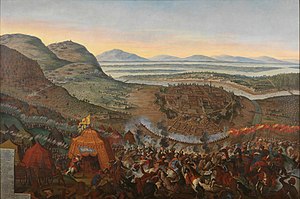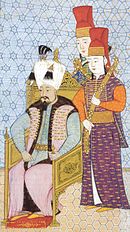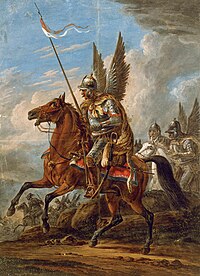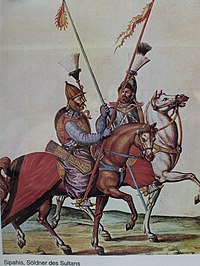Battle of Vienna
This article needs additional citations for verification. (November 2010) |
| Battle of Vienna | |||||||
|---|---|---|---|---|---|---|---|
| Part of the Great Turkish War, Ottoman–Habsburg wars and the Polish–Ottoman War | |||||||
 Battle of Vienna on 12 September 1683 | |||||||
| |||||||
| Belligerents | |||||||
|
|
Ottoman fiefdoms: File:Flag of Krim Khanat.svg Khanate of Crimea | ||||||
| Commanders and leaders | |||||||
|
|
| ||||||
| Strength | |||||||
| 84,400 | 150,000 | ||||||
| Casualties and losses | |||||||
|
Among other losses:
| Unknown | ||||||
The Battle of Vienna (German: Schlacht am Kahlenberg, Polish: Bitwa pod Wiedniem or Odsiecz Wiedeńska, Turkish: İkinci Viyana Kuşatması, Ukrainian: Віденська відсіч / Viděns'ka Vidsič) took place on 12 September[2] 1683 after Vienna had been besieged by the Ottoman Empire for two months. It was a battle of The Holy League versus the Ottoman Empire and fiefdoms of the Ottoman Empire near the Kahlenberg mountain in Vienna. The battle marked the beginning of the political hegemony of the Habsburg dynasty in Central Europe.
The Viennese army was led by Ernst Rüdiger Graf von Starhemberg subordinate of Leopold I Habsburg, Holy Roman Emperor.
The large-scale battle was won by Polish-Lithuanian, Hungarian, Austrian and German forces commanded by King of Poland Jan III Sobieski versus the Ottoman Empire army and the Ottoman fiefdoms armies commanded by Grand Vizier Merzifonlu Kara Mustafa Pasha.
The siege itself began on 14 July 1683, by the Ottoman Empire army of approximately 150,000 men.[3] The besieging force was composed of 60 ortas of Janissaries (12,000 men paper strength) with an observation army of c.70,000[4] men watching the countryside. The decisive battle took place on 12 September, after the united relief army of approximately 80,000 men had arrived.
It has been suggested by some historians that the battle marked the turning point in the Ottoman–Habsburg wars, the 300-year struggle between the forces of the Central European kingdoms and the Ottoman Empire. However, an opposing view sees the battle as only confirming the already-decaying power of the Ottoman Empire. Over the sixteen years following the battle, the Habsburgs of Austria gradually occupied and dominated southern Hungary and Transylvania, which had been largely cleared of the Ottoman forces. The battle is also notable for including the largest cavalry charge in history.
Prelude

| Troops | Infantry | Cavalry and Dragoons | Cannons | Total |
|---|---|---|---|---|
| 29,600 | 17,800 | 124 | 47,250 | |
| |
8,100 | 10,350 | 70 | 18,400 |
| |
7,500 | 3,000 | 26 | 10,500 |
| |
7,000 | 2,500 | 12 | 9,500 |
| |
7,000 | 2,000 | 16 | 9,000 |
| 16,450 | 20,550 | 28 | 37,000[5] | |
| Habsburgs and their confederates estimated total: | 46,050 | 38,350 | 152 | 84,400 |
The capture of the city of Vienna had long been a strategic aspiration of the Ottoman Empire, due to its inter-locking control over Danubean (Black Sea-to-Western Europe) southern Europe, and the overland (Eastern Mediterranean-to-Germany) trade routes. During the years preceding the second siege (the first one was in 1529), under the auspices of grand viziers from the influential Köprülü family, the Ottoman Empire undertook extensive logistical preparations this time, including the repair and establishment of roads and bridges leading into Austria and logistical centers, as well as the forwarding of ammunition, cannon and other resources from all over the Empire to these logistical centers and into the Balkans.

On the political front, the Ottoman Empire had been providing military assistance to the Hungarians and to non-Catholic minorities in Habsburg-occupied portions of Hungary.[citation needed] There, in the years preceding the siege, widespread unrest had become open rebellion upon Leopold I's pursuit of Counter-Reformation principles and his desire to crush Protestantism. In 1681, Protestants and other anti-Habsburg Kuruc forces, led by Imre Thököly, were reinforced with a significant force from the Ottomans, who recognized Thököly as King of "Upper Hungary" (eastern part of today's Slovakia and parts of today's northeastern Hungary, which he had earlier taken by force of arms from the Habsburgs). This support went so far as explicitly promising the "Kingdom of Vienna" to the Hungarians if it fell into Ottoman hands.[citation needed]

Yet, before the siege, a state of peace had existed for twenty years between the Habsburgs and the Ottoman Empire, as a result of the Peace of Vasvár.
In 1681 and 1682, clashes between the forces of Imre Thököly and the Habsburgs' military frontier (which was then northern Hungary) forces intensified, and the incursions of Habsburg forces into Central Hungary provided the crucial argument of Grand Vizier Kara Mustafa Pasha in convincing the Sultan, Mehmet IV and his Divan, to allow the movement of the Ottoman Army. Mehmet IV authorized Kara Mustafa Pasha to operate as far as Győr (the name during Ottoman period: Yanıkkale, German: Raab) and Komárom (Turkish: Komaron, German: Komorn) castles, both in northwestern Hungary, and to besiege them. The Ottoman Army was mobilized on 21 January 1682, and war was declared on 6 August 1682.

The logistics of the time meant that it would have been risky or impossible to launch an invasion in August or September 1682 (a three month campaign would have got the Ottomans to Vienna just as winter set in). However this 15 month gap between mobilization and the launch of a full-scale invasion allowed ample time for the Habsburg forces to prepare their defense and set up alliances with other Central European rulers, and undoubtedly contributed to the failure of the campaign. It proved most decisive that the Habsburgs and Poland concluded a treaty during this winter in which Leopold would support Sobieski if the Ottomans attacked Kraków; in return, the Polish Army would come to the relief of Vienna, if attacked.
On 31 March 1683 another declaration, sent by Kara Mustafa on behalf of Mehmet IV, arrived at the Imperial Court in Vienna. On the next day the forward march of Ottoman army elements began from Edirne in Thrace. The troops reached Belgrade by early May, then moved toward the city of Vienna. About 40,000 Crimean Tatar forces arrived 40 km east of Vienna on 7 July, twice as many as the Austrian forces in that area. After initial fights, Leopold retreated to Linz with 80,000 inhabitants of Vienna.
The King of Poland Jan III Sobieski prepared a relief expedition to Vienna during the summer of 1683, honoring his obligations to the treaty. He went so far as to leave his own nation virtually undefended when departing from Kraków on 15 August. Sobieski covered this with a stern warning to Imre Thököly, the leader of Hungary, whom he threatened with destruction if he tried to take advantage of the situation — which Thököly tried to. Jan Kazimierz Sapieha the Younger delayed the march of the Lithuanian army, instead devastating the Hungarian Highlands (now Slovakia), and arrived in Vienna after it was relieved.[6]
Events during the siege


The main Ottoman army finally invaded Vienna on 14 July. On the same day, Kara Mustafa sent the traditional demand for surrender to the city.[7]
Ernst Rüdiger Graf von Starhemberg, leader of the remaining 11,000 troops and 5,000 citizens and volunteers with 370 cannons, refused to capitulate. Only days before, he had received news of the mass slaughter at Perchtoldsdorf,[8] a town south of Vienna whose citizens had handed over the keys of the city after having been given a similar choice.
The Viennese had demolished many of the houses around the city walls and cleared the debris, leaving an empty plain that would expose the Ottomans to defensive fire if they tried to rush the city. Kara Mustafa Pasha solved that problem by ordering his forces to dig long lines of trenches directly toward the city, to help protect them from the defenders as they advanced steadily toward the city.
Although the Ottomans had 300 good cannons, the fortifications of Vienna were very strong and up to date, and the Ottomans had to find a more effective use for their gunpowder: mining. Tunnels were dug under the massive city walls to blow them up with substantial quantities of black powder.
The lack of urgency by the Ottomans at this point, combined with the delay in advancing their army after declaring war, eventually allowed a relief force to arrive. Historians have speculated that Kara Mustafa wanted to take the city intact for its riches, and declined an all-out attack in order to prevent the right of plunder which would accompany an assault.[9]
The Ottoman siege cut virtually every means of food supply into Vienna,[10] and the garrison and civilian volunteers suffered extreme hardships. Fatigue became such a problem that Graf Ernst Rüdiger von Starhemberg ordered any soldier found asleep on watch to be shot. Increasingly desperate, the forces holding Vienna were on their last legs when in August, Imperial forces under Charles V, Duke of Lorraine beat Imre Thököly of Hungary at Bisamberg, 5 km northwest of Vienna.
On 6 September, the Poles under Jan III Sobieski crossed the Danube 30 km north west of Vienna at Tulln, to unite with the Imperial forces; additional troops from Saxony, Bavaria, Baden, Franconia and Swabia arrived because of the call of Habsburgs who were supported by Pope Innocent XI. Only Louis XIV of France, Habsburg's rival, not only declined to help, but used the opportunity to attack cities in Alsace and other parts of southern Germany, as in the Thirty Years' War decades earlier, in the War of the Reunions.
During early September, the experienced 5,000 Ottoman sappers repeatedly blew up large portions of the walls, the Burg bastion, the Löbel bastion and the Burg ravelin in between, creating gaps of about 12m in width. The Austrians tried to counter by digging their own tunnels, to intercept the depositing of large amounts of gunpowder in subterranean caverns. The Ottomans finally managed to occupy the Burg ravelin and the Nieder wall in that area on 8 September. Anticipating a breach in the city walls, the remaining Austrians prepared to fight in Vienna itself.
Staging the battle

The relief army had to act quickly to save the city from the Ottomans, and to prevent another long siege in which they might take it. Despite the international composition and the short time of only six days, an effective leadership structure was established, indisputably centered on the King of Poland and his heavy cavalry. The motivation was high, as this war was not as usual for the interests of kings, but for Christian faith. And, unlike the Crusades, the battleground was in the heart of Europe.
Kara Mustafa Pasha, on the other hand, was less effective, despite having months of time to organize his forces, ensure their motivation and loyalty, and prepare for the expected relief army attack. He had entrusted defense of the rear to the Khan of Crimea and his cavalry force, which numbered about 30 - 40,000.

There are serious questions as to how much the Tatar forces participated in the final battle at Vienna. Their Khan felt humiliated by repeated snubs by Kara Mustafa. He reportedly refused to attack the Polish relief force as it crossed the mountains, where the Tatar light horse would have had an advantage over the Polish heavy cavalry.[9] Nor were they the only component of the Ottoman army to defy Mustafa openly or refuse assignments.
This left vital bridges undefended and allowed passage of the combined Polish army, which arrived to relieve the siege. Critics of this account say that it was Kara Mustafa Pasha, and not the Crimean Khan, who was held responsible for the failure of the siege.
Also, the Ottomans could not rely on their Wallachian and Moldavian allies. The Romanians resented the Ottomans, who extracted heavy tributes from their countries. The Ottomans also intervened in the internal politics of these countries, seeking to replace their ruling princes with men who would be mere Ottoman puppets. When George Ducas, Prince of Moldavia and Şerban Cantacuzino, Prince of Wallachia learned of the Ottoman plans, they tried to warn the Habsburgs. They also tried to avoid participating in the campaign, but the Ottomans insisted that they send troops. There are a great number of popular legends about the Wallachian and Moldavian forces in the siege. Almost invariably, these legends describe them loading their cannons with straw balls, in order to make no impact upon the walls of the besieged city.
Habsburg confederated troops arrived on the Kahlenberg above Vienna, signaling their arrival with bonfires. In the early morning hours of 12 September, before the battle, a Mass was held for the King of Poland and his nobles.
Battle


The battle started before all units were fully deployed. Early in the morning, at 4 AM, the Ottomans attacked, seeking to interfere with the deployment of the Holy League troops. Charles of Lorraine moved forward with the Austrian army on the left and the German forces in the center.
Mustafa Pasha launched a counter-attack, with most of his force, but held back some of the elite Janissary and Sipahi units for a simultaneous assault on the city. The Ottoman commanders had intended to take Vienna before Sobieski arrived, but time ran out. Their sappers had prepared another large and final detonation under the Löbelbastei,[11] to breach the walls. While the Ottomans hastily finished their work and sealed the tunnel to make the explosion more effective, the Austrian "moles" detected the tunnel in the afternoon. One of them entered and defused the load just in time.
At that time, above the "subterranean battlefield", a large battle was going on, as the Polish infantry launched a massive assault upon the Ottoman right flank. Instead of focusing on the battle with the relief army, the Ottomans tried to force their way into the city, carrying their crescent flag.[citation needed]
After twelve hours of fighting, the Poles held the high ground on the right. The Holy League cavalry waited on the hills, and watched the infantry battle for the whole day. Then at about 5 PM King of Poland ordered the attack, the cavalry attacked in four groups. One group was Austrian-German, and the other three were Polish. Twenty thousand horsemen charged down the hills (the largest cavalry charge in history).[citation needed] The charge was planned and led by King of Poland Jan III Sobieski at the head of 3,000 Polish heavy lancers, the famed "Winged Hussars". The Lipka Tatars who fought on the Polish side wore a sprig of straw in their helmets to distinguish themselves from the Tatars fighting on the Ottoman side. The charge broke the lines of the Ottomans, who were tired from the long fight on two sides. In the confusion, the cavalry headed straight for the Ottoman camps, while the remaining Vienna garrison sallied out of its defenses and joined in the assault.
The Ottoman troops were tired and dispirited following the failure of both the sapping attempt and the brute force assault on the city. The arrival of the cavalry turned the tide of battle against them, sending them into retreat to the south and east. In less than three hours after the cavalry attack, the Christian forces had won the battle and saved Vienna.
After the battle, Sobieski paraphrased Julius Caesar's famous quote by saying "Venimus, Vidimus, Deus vincit" - "We came, We saw, God conquered".

Aftermath
The Ottomans lost at least 15,000 men dead and wounded in the fighting, plus at least 5,000 men captured and all cannons, compared to approximately 4,500 dead and wounded for the Habsburg-Polish forces.
The loot that fell into the hands of the Holy League troops and the Viennese was as huge as their relief, as King Sobieski vividly described in a letter to his wife a few days after the battle:
Ours are treasures unheard of ... tents, sheep, cattle and no small number of camels ... it is victory as nobody ever knew of, the enemy now completely ruined, everything lost for them. They must run for their sheer lives ... Commander Starhemberg hugged and kissed me and called me his savior.[12]
This emotional expression of gratitude did not distract Starhemberg from ordering the immediate repair of Vienna's severely damaged fortifications, guarding against a possible Ottoman counter-strike. However, this proved unnecessary. The victory at Vienna set the stage for Prince Eugene of Savoy's re-conquering of Hungary and (temporarily) some of the Balkan lands within the following years. Austria signed a peace treaty with the Ottoman Empire in 1699.
Long before that, the Ottomans had disposed of their defeated commander. On 25 December 1683, Kara Mustafa Pasha was executed in Belgrade (in the approved manner, by strangulation with a silk rope pulled by several men on each end) by order of the commander of the Janissaries.
Significance


The Ottomans fought on for another 16 years, losing control of Hungary and Transylvania in the process, before finally giving up. The end of the conflict was finalized by the Treaty of Karlowitz.
The battle marked the historic end of the expansion of the Ottoman Empire into Europe .
The behavior of Louis XIV of France also set the stage for centuries to come: German-speaking countries had to fight wars simultaneously in the West and the East. While German troops were fighting for the Holy League, Louis ruthlessly used the occasion, before and after the battle of Vienna, to annex territories in western Europe, such as Luxembourg, Alsace with Strasbourg, etc. Due to the ongoing war against the Ottomans, Austria could not support the interest of German allies in the West. The biography of Ezechiel du Mas, Comte de Melac illustrates the devastations of large parts of Southern Germany by France.


In honor of Sobieski, the Austrians erected a church atop a hill of Kahlenberg, north of Vienna. The train route from Vienna to Warsaw is also named in Sobieski's honour. The constellation Scutum Sobieskii (Sobieski’s Shield) was named to memorialize the battle.[13] Because Sobieski had entrusted his kingdom to the protection of the Blessed Virgin (Our Lady of Czestochowa) before the battle, Pope Innocent XI commemorated his victory by extending the feast of the Holy Name of Mary, which until then had been celebrated solely in Spain and the Kingdom of Naples, to the universal Church; it is celebrated on 12 September.
Cultural legacy
After the battle of Vienna, the newly identified constellation Scutum (Latin for shield) was originally named Scutum Sobiescianum by the astronomer Johannes Hevelius, in honor of Jan III Sobieski. While there are some few stars named after non-astronomers, this is the only constellation that was originally named after a real non-astronomer, who was still alive when the constellation was named.
Religious significance
The feast of the Holy Name of Mary is celebrated on 12 September on the liturgical calendar of the Catholic Church in commemoration of the victory in this battle of Christian Europe over the Muslim forces of the Ottoman Empire. Before the battle King Jan had placed his troops under the protection of the Blessed Virgin Mary. After the battle Pope Innocent XI, wishing to honor Mary, extended the feast to the entire Church.
Musical legacy
It is said that when the Ottomans were pushed away from Vienna the military bands left their instruments on the field of battle, and that is how the Holy Roman Empire (and therefore the other Western countries) acquired cymbals, triangles, and bass drums.
The Austrian composer Johann Joseph Fux memorialized the battle in his Partita Turcaria, which bore the sub-title, "Musical portrait of the Siege of Vienna by the Turks in 1683".[14]
Culinary legends
Several culinary legends are related to the Battle of Vienna.
One legend is that the croissant was invented in Vienna, either in 1683 or during the earlier siege in 1529, to celebrate the defeat of the Ottoman attack of the city, with the shape referring to the crescents on the Ottoman flags. This version of the origin of the croissant is supported by the fact that croissants in French are referred to as Viennoiserie, and the French popular belief that Vienna-born Marie Antoinette introduced the pastry to France in 1770.
Another legend from Vienna has the first bagel as being a gift to King Jan Sobieski to commemorate the King's victory over the Ottomans that year. It was fashioned in the form of a stirrup, to commemorate the victorious charge by the Polish cavalry. The veracity of this legend is uncertain, as there is a reference in 1610 to a bread with a similar-sounding name, which may or may not have been the bagel.
After the battle, the Austrians discovered many bags of coffee in the abandoned Ottoman encampment. Using this captured stock, Franciszek Jerzy Kulczycki opened the third coffeehouse in Europe and the first in Vienna,[15][16] where, according to legend, Kulczycki himself added milk and honey to sweeten the bitter coffee, thereby inventing cappuccino. There is no contemporary historical source connecting Marco d'Aviano, the Capuchin friar and confidant of Leopold I, Holy Roman Emperor, to this spurious creation.
See also
Notes
- ^ comments on XVII century epistolography by Antoni Zygmunt Helcel, 1860, Kraków
- ^ Date of Battle
- ^ siege of vienna (europe 1683) -- Britannica Onl
- ^ Bruce, George (1981). Harbottle's Dictionary of Battles. Van Nostrand Reinhold.
- ^ Exact Polish Order of Battle and Strength Reports as of 1 August 1683
- ^ Davies, Norman, God's Playground, a History of Poland: The origins to 1795, (Columbia University Press, 1982), 487.
- ^ The original document was destroyed during World War II. For the German translation, see here
- ^ Palmer, Alan, The Decline and Fall of the Ottoman Empire, p.12, Published by Barnes & Noble Publishing, 1992. ISBN 1-56619-847-X
- ^ a b Bates, Brandon J. (2003). "The Beginning of the End: The Failure of the Siege of Vienna of 1683" (PDF). Brigham Young University. Archived from the original (PDF) on 22 August 2006. Retrieved 28 August 2006.
- ^ Ripperton, Lisa. "The Siege of Vienna". The Baldwin Project. Retrieved 28 August 2006.
- ^ "Duell im Dunkeln" (in German). 2DF. 6 November 2005. Retrieved 28 August 2006.
- ^ "Letter from King Sobieski to his Wife". Letters from King Sobieski to his wife. University Of Gdansk, Department Cultural Studies Faculty of Philology. Retrieved 4 August 2011.
- ^ Grzechnik, Slawek K. "Hussaria – Polish Winged Cavalry". Archived from the original on 15 June 2006. Retrieved 28 August 2006.
- ^ Description of contents of album "Alla Turca"
- ^ Pendergrast, Mark. Uncommon Grounds, p.10. Basic Books, 2000. ISBN 0-465-05467-6
- ^ Millar, Simon. Vienna 1683, p. 93. Osprey Publishing, 2008. ISBN 1-84603-231-8.
References
- Stéphane Gaber, Et Charles V arrêta la marche des Turcs, Presses universitaires de Nancy, 1986, ISBN 2-86480-227-9.
- Bruce, George (1981). Harbottle's Dictionary of Battles. Van Nostrand Reinhold.
- Cezary Harasimowicz "VICTORIA" Warsaw 2007, novel ISBN 978-83-925589-0-3
- Alan Palmer, The Decline and Fall of the Ottoman Empire, Published by Barnes & Noble Publishing, 1992. ISBN 1-56619-847-X.
External links
- Polish-Lithuanian Commonwealth Army in XVIIth century
- Polish Order of battle, From J. Wimmer "Wieden 1683"
- Template:De icon http://www.turkin.net/kunst/osmanen_belagerung2.htm
- Template:De icon http://www.wien-vienna.at/tuerkenkriege.htm
- Template:De icon German TV: Türken vor Wien
- Template:De icon Arte TV: Türken vor Wien
- http://victoria-film.com/ web site about a feature film in development, a documentary, a novel
- Türkenbelagerung - Die Heere
- Use dmy dates from November 2010
- Conflicts in 1683
- 1683 in Austria
- Battles of the Great Turkish War
- Battles involving the Ottoman Empire
- Battles involving Poland
- Military history of Austria
- History of Vienna
- Military history of Germany
- Sieges involving the Ottoman Empire
- 17th century in the Ottoman Empire
- Austria–Turkey relations
- Cavalry charges



